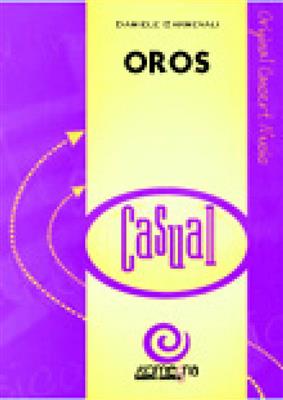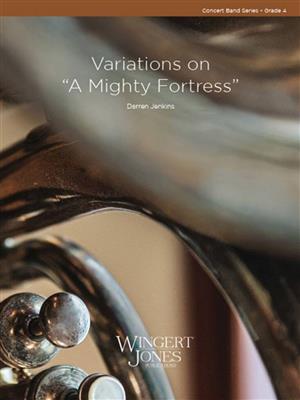Results
-
 £105.80
£105.80Oros, Little Suite - Daniele Carnevali
This piece was commissioned for the second edition of the "Suoni d'Aspromonte" National Competition which is held in Cittanova in the province of Reggio Calabria. The title, Oros, from the ancient Greek word for "mount", is a clear reference to the Greek culture that colonised Calabria and the magnificence of the Aspromonte massif that dominates the entire region: forests, towns and sea. The piece consists of three movements: Entrata, Serenata and Corteggio, offering rhythms and melodies that reflect present-day tastes rather than local musical traditions. It is specifically intended for bands with lots of young members.
Estimated dispatch 7-14 working days
-
 £120.40
£120.40Intermissions - Daniele Carnevali
This piece was commissioned by the organising committee of the "La Prime Luz 1812" national band contest, held in Bertiolo (Udine), as the compulsory piece for category A. It consists of three movements and, rated as a first international category or national excellence grade piece, it requires the appropriate variety of timbres and instrumentalists with the necessary skills. The themes, enhanced by the use of unusual tones and compound beats, are often broken, interrupted: hence the title of the piece, intermissions, meaning interruptions. The unifying element is the musical language that, through the use of artificial modes and fourths, seeks to create a balance between tensions of differing intensity and nature.
Estimated dispatch 7-14 working days
-
 £113.30
£113.30Moderate Dances - Angelo Sormani
This piece is a tribute to dance music, especially passionate, intense and meditative dance music. "Moderate Dances" is divided into three movements: a "Tango", a "Slow Waltz" and a "Bossa Nova". Each movement and each dance has its own particular characteristics but, when combined, these different rhythmic beats and times give the piece a feeling of completeness and uniformity. The Tango started to flourish in the suburbs of Buenos Aires in around 1880. There is still some doubt as to its origins, which may be Cuban (Habanera) but are probably African. It was most popular in Argentina and Brazil: here the male protagonist was originally the "gaucho" with his inseparable guitar, later to be replaced by the proud, elegant "compadre". By around 1910 the Tango had spread to Italy and France. New clubs opened, where the upper classes could watch and dance the Tango. Here the dance also underwent some rapid transformations. The exaggerated and extravagant gestures and body movements disappeared. Slow, gliding steps replaced the old rotational movements. The women's red ankle-boots and the partners "staring into each other's eyes" accentuated the erotic nature and sensuality of this dance. So much so that, in 1913, the German government banned soldiers from dancing the Tango. Those who broke the law were immediately discharged from the army. From a strictly musical perspective, the basic instruments were a flute, a harp (the diatonic harp typically played by the Indians of Paraguay) and a violin, or flute, guitar and violin or even clarinet, guitar and violin. These instruments were easy to transport, ideal for playing at parties, in the streets and in courtyards. The musicians played by ear, frequently improvising: there were no scores, no records, which is the main reason why it is impossible to trace the Tango back to its exact origins. However, the Tango's evolution (and growing popularity) was once again fostered by its fundamental ability to absorb "other" cultures, languages and sounds. And it was the arrival of the "bandoneon" (an accordion-like instrument that was invented in Germany and brought to Rio de la Plata by some immigrant), which replaced the flute, that marked the beginning of the Tango's huge success outside Argentina. A number of talented composers, above all the great Astor Piazzola (1921-1992), transformed the bandoneon from a simple accompanying instrument to a solo instrument that was to become the distinguishing feature of the 20th century Tango. The Slow Waltz originated from the Waltz, the typical dance of the Bavarian and Tyrolese peasants in the 1700s. It was composers like Johann Strauss, father and son, who carried the Waltz to its zenith in the 1800s, creating the sensual and melancholy yet joyful and charming dance we are all familiar with. When the Waltz first became popular in Germany, the members of respectable society were shocked at the closeness of the dancing partners, who had always previously danced apart. The main difference between the Waltz and Slow Waltz is that the latter has a slower, more expressive rhythm: the men wear tails and the women wear ball gowns decorated with beads and feathers and couples dance in graceful rotational movements. "Bossa Nova" is the title of the last movement in the piece. Jobim, the great Brazilian musician, described this musical genre as a combination of modern Jazz and Samba. Bossa Nova means "new wave". This was the name of the artistic and musical movement that evolved in Brazil in the late Fifties and was extremely popular throughout the Sixties. The songs are usually about love or social matters, drawing inspiration from the slums of Rio De Janeiro and the lives of their inhabitants. Bossa Nova, with its original compositions and the artistic talent of its musicians, also became hugely popular in the United States and Europe, and top Jazz musicians (Ella Fitzgerald, Stan Getz, Bob Cooper, Charlie Bird, Sonny Rollins, Dexter Gordon, Dizzy Gillespie) started to include Bossa in their repertoires.
Estimated dispatch 7-14 working days
-
 £82.50
£82.50Silver Jubilee Overture - John Edmondson
The 1984 effort by the well-known composer is currently found on several state lists. Three contrasting sections make up the Overture, beginning with a brisk rhythmic introduction which is followed by a slow melodic theme featuring flutes. An entrance by the percussion brings back the original theme with the full band building to a majestic finale. ( 5 minutes 30 seconds)
Estimated dispatch 7-14 working days
-
 £71.50
£71.50If You're Happy - Robert E. Foster
This one is a natural for that lighter moment in your young bands concert! The students and the audience will have fun with the hand claps and foot stomps. Theres lots of great teaching points too as your band gets to move through three simple keys!
Estimated dispatch 7-14 working days
-
 £71.50
£71.50Beethoven For Band - Ludwing Van Beethoven
This work introduces the major themes from three of the most famous and popular symphonies ever written - Beethovens Symphony No. 5, Symphony No. 7 and Symphony No. 9 - which are readily recognizable and easily learned, serving as a good introduction to some of the great masterpieces of western civilization. (2 minutes 45 seconds)
Estimated dispatch 7-14 working days
-
 £71.50
£71.50Americanarama - Robert E. Foster
Make learning fun with this tuneful setting of three popular early American songs. Ring, Ring the Banjo and Camptown Races are included in this delightful and educational arrangement thats upbeat and vibrant. The Girl I Left Behind Me makes the perfect feature for flute solo or the flute section and snare drum for an effective taste of colonial America.
Estimated dispatch 7-14 working days
-
 £104.50
£104.50Winterfest - John Prescott
As exhilarating as a brisk race across a frozen lake, this selection will brighten the spirits and turn up the excitement this holiday season! Imagine ice skating around a lake where winter festivals are taking place. In one community youll hear Jingle Bells, in another youll hear folk music and in yet another youll hear Deck the Halls. Finally, as you race to the center of the lake youll hear the music of all three celebrations in a grand seasonal finale!
Estimated dispatch 7-14 working days
-
 £82.50
£82.50On The Merrimack - Andrew Boysen Jr.
On the Merrimack was commissioned by Chris Martin and the Southside Middle School Band, Manchester, New Hampshire (Matthew Hammond, director), and is dedicated to the city of Manchester, New Hampshire. Constant throughout the history of the region was the central importance of the Merrimack River. The material of the piece represents the three main periods of development: The Pennacook Indians; Amoskeag and the Mills and Technology and Growth, with connective sections representing the ever-present river. Much of the melodic material for the piece is taken from the French Canadian folksong, Weaving in the United States.
Estimated dispatch 7-14 working days
-
 £104.50
£104.50Variations On A Mighty Fortress - Darren W. Jenkins
A truly powerful setting that is worthy of this famous hymn that uses an impressive set of three variations. It opens with a slow, legato presentation of the melody stated by solo trumpet followed by the first lively variation, driven by a strong rhythmic accompaniment. The second variation features an alto saxophone solo that builds and alternates between woodwind and brass choirs before closing with a majestic fanfare and the full ensemble driving to a jubilant conclusion. Extremely uplifting!
Estimated dispatch 7-14 working days
